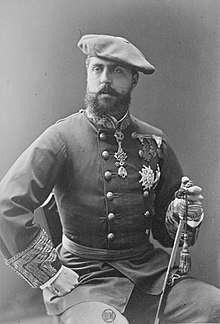Manuel Santa Cruz Loidi
Manuel Ignacio Santa Cruz Loidi (1842–1926) was a Spanish Roman Catholic priest. For some 35 years he served on apostolic mission in Colombia, where he was heading a parish in rural interior of the Pasto province; for some 15 years he held also various minor posts in Jamaica. He is best known, however, for his activity in 1872-1873, when he commanded a Carlist guerilla unit during the civil war in Spain. As "cura Santa Cruz" (priest Santa Cruz) or simply as "El Cura" (The Priest) he gained notoriety for cruelty and in the Spanish public discourse of the late 19th century he became a symbol of savage brutality. In this role – though also with a grade of ambiguity - he featured as a protagonist in a few great works of Spanish Modernist literature of the early 20th century and became a mythical figure long before his own death.
Manuel Santa Cruz Loidi | |
|---|---|
| Born | Manuel Santa Cruz Loidi 1842 Elduain, Spain |
| Died | 1926 |
| Nationality | Spanish |
| Known for | guerilla leader |
| Political party | Carlism |
Family and youth
Manuel Santa Cruz Loidi was descendant to Basque rural working-class families; generations of his ancestors were farmers living in the Oria river valley, in the Gipuzkoan county of Tolosa. His paternal grandfather Pascual de Santa Cruz was a native of Andoain yet he settled in Elduain, probably on the economy of his wife María Bautista Sarove. Their son and the father of Manuel Ignacio, Francisco Antonio Santa Cruz Sarove (1784-1842), in 1824 married Juana Josefa Loidi Urrestarazu (1803–1871); she was the daughter of Miguel Ignacio Loidi, a native of Amezketa, and María Ignacia Urrestarazu, who originated from Orendain.[1] The couple lived in Elduain; their caserio, known as Zamonea, was among the poorer ones in the village.[2] It is not clear how many children they had, though according to some sources Manuel Ignacio was not their only child and he had at least one sister.[3] Following the death of her husband María Ignacia remarried with a widower Juan Ignacio Betelu Muñagorri (1795–1861); it is not clear whether they had any offspring.[4]
Manuel was raised by his mother and step-father and initially did not differ from other village boys. It is not clear where he was first educated; at some stage he was taken care of by his much older paternal cousin, a local priest Francisco Antonio Sasiain Santa Cruz (1812–1898); he taught the teenager Latin and apparently directed him towards the religious career.[5] Indeed, in 1861 Manuel entered the seminary in Vitoria; during the first 3 years he was obtaining high grades and was rewarded with the meritissimus title; later his performance worsened, reportedly due to health problems.[6] He was ordained as a priest in 1866 and posted to Hernialde, a village a few miles from his native one. According to some sources he was first nominated a coadjutor;[7] other authors claim he initially acted as a vicar.[8] Following the death of the parish priest it was Santa Cruz who became his successor at an unspecified time in the late 1860s; he allegedly assumed his duties with frenetic energy and as a spiritual shepherd he tended to rigidity, himself adhering to an austere living pattern.
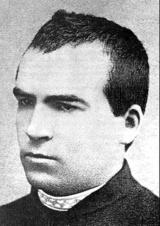
Since his father had served as a Carlist volunteer during the last civil war[9] and since legitimist sympathies prevailed among the rural Gipuzkoan folk,[10] it is likely that Manuel from his youth was growing in an ambience strongly flavored with Carlism.[11] His position was probably strengthened during the seminary years, as Carlism was popular also among the lower and regular clergy of the province.[12] In line with the Traditionalist outlook Santa Cruz assumed a decisively hostile stand towards the 1868 revolution, from behind the pulpit lambasting the new regime as an ungodly, depraved system.[13] His inflammatory sermons gained him attention of the authorities; in October 1870 a Guardia Civil patrol[14] showed up in Hernialde to detain him after a Sunday Mass. Santa Cruz took advantage of a somewhat loose approach of his captors and fled, in a few days crossing to France.[15]
Guerilla leader
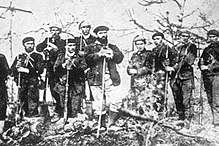
Following some 18 months of exile in Bayonne,[16] in 1872–73 Santa Cruz was taking part in the guerilla warfare prior and during the Third Carlist War. His record falls into 4 separate strings: from April till May 1872,[17] from June till August 1872,[18] from December 1872 till July 1873,[19] and in December 1873,[20] all separated by periods of taking refuge in France. Initially, he joined a unit led by a Carlist veteran Pedro Recondo; serving as a chaplain, Santa Cruz was gaining experience in rural irregular tactics. Since the summer of 1872 he was leading his own troops; initially the group consisted of some 15–25 men, but later it grew and in literature is estimated at 200,[21] 500, or even 1,000, with an informal, in-between command structure built up. The detachment was rather loosely incorporated into the Carlist war effort; at early stages it was assigned a vague task of "guarding the Northern borderline" by the legitimist general staff, yet it seems that the unit retained great autonomy and operated independently.
In military terms the activity of Santa Cruz’ unit consisted of harassing the enemy logistics network and raiding minor garrisons.[22] The former included disrupting postal service,[23] arms transports,[24] or railway connections;[25] the latter included descending upon smaller locations[26] and destroying archives, pillaging Guardia Civil or Carabineros posts, abducting local officials, and staging shows of prowess. The Liberal high command was forced to diminish their frontline strength and to assign more troops to vigilance and patrol duties. However, in line with his guerilla strategy Santa Cruz avoided open confrontation against enemy forces; cases of accepting a battle usually resulted in defeat, e.g. in Aia.[27] When facing enemy roundup Santa Cruz used to disband his group and to set re-assembly terms; taking advantage of perfect familiarity with the mountainous Gipuzkoan countryside and support of the local population, he kept evading the governmental chase. Santa Cruz operated across all the province of Gipuzkoa, though he was noted also in neighboring areas of Biscay,[28] Álava, and particularly Navarre.[29]
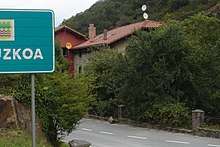
Since early 1873 Santa Cruz gained notoriety for cruelty and was charged with committing acts of barbarity.[30] They consisted of executions of prisoners,[31] including women[32] or members of his own unit when suspected of treason, burning down settlements, or administering corporal punishment.[33] The episode which caused particular outrage occurred in June 1873, when santacrucistas assaulted a fortified provincial border control post in Endarlaza.[34] Claiming that during the shootout the defenders had mischievously displayed a white flag to fire at the approaching Carlists later on, Santa Cruz had his men execute 35 carabineros who had ultimately surrendered. The Carlist high command was continuously uneasy about Santa Cruz;[35] the Enderlaza episode proved to be the last straw.[36] The local legitimist commander general Antonio Lizarraga, who was trying to bring Santa Cruz in line for some time, demanded that the insubordinate priest back down. Eventually, Santa Cruz found himself hunted down by the Liberals and the Carlists alike; he disbanded his unit and withdrew into France.[37]
France, Britain and Jamaica
In France Santa Cruz seemed disoriented and with no direction;[38] he spent more than a year mostly in small villages in the French Basque country.[39] Some of his former men suggested resumption of warfare, though Lizarraga confirmed that in such case he would be persecuted.[40] The Madrid government filed a request for extradition, turned down by the French.[41] Gendarmarie kept a close watch on him and at one point Santa Cruz was detained in Bayonne;[42] he was pressed to leave the country. In late 1874 or early 1875 he found himself in the Jesuit college in Lille; thanks to support of the Cambrai archbishop René-François Régnier, Santa Cruz's plea for clemency was accepted in the Vatican and he was reinstated to regular religious duty,[43] abandoned during the wartime years.[44] He intended to commence missionary service;[45] as part of his preparation the Jesuits directed him to their establishment in Britain, where Santa Cruz was to learn English. In early 1876 he met his king Carlos VII in London but accounts differ;[46] according to some Santa Cruz defended his wartime record,[47] according to others he regretted his conduct and begged for mercy.[48] Shortly afterwards he sailed to Jamaica.[49] The Catholic administration of the island since the 1840s had been dominated by the English Jesuit province and since the 1860s their activity was on the rise;[50] Santa Cruz was dispatched in a group of 3 priests.[51]
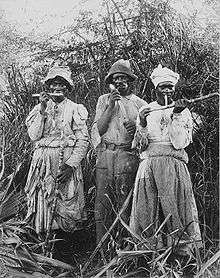
Upon crossing the Atlantic Santa Cruz abandoned the first surname and started using only his maternal one; hence, in America he became known as Manuel Loidi. In December 1876 he was first recorded as performing religious service in Jamaica;[52] he was later to serve in the parishes of St. Andrews, Portland and St. Mary, all located in the Eastern part of the island.[53] His exact position in the religious structure is not clear; in documentation available he is listed as "clergyman";[54] until the early 1880s he is recorded usually as administering baptisms,[55] marriages[56] and especially funerals,[57] mostly though not exclusively in the location of King's Weston. At one point or another he served in 5 different mission stations and himself founded another nine.[58] Today he is particularly noted for his work in the small Preston Hill village, one of the first Catholic congregations outside Kingston[59] and inhabited mostly by descendants of the Castle Mine slaves. Santa Cruz is credited with construction of a wooden St. Francis Xavier church, which served the faithful for decades.[60] It seems that Santa Cruz and the Jamaica Jesuits lived in extreme poverty, as the destitute and barren local Catholic community was hardly in a position to support them.[61] It is not clear why Santa Cruz abandoned Jamaica in 1891 or 1892; it is likely that his leaving the island was related to change in missionary administration, as in the early 1890s the Jamaica mission was allotted to the Maryland-New York Jesuit province and soon the US Jesuits took over.[62]
Colombia
It is not clear in what circumstances Santa Cruz moved to Colombia; one version is that the option was suggested and facilitated by an anonymous, influential Spanish Jesuit and a friend of his.[63] Santa Cruz agreed to join Colegio Javieriano,[64] which served as a Jesuit college and a seminary in Pasto, capital of Nariño department. He arrived in the city in 1892, possibly having spent some time in Panama earlier.[65] In the college he was teaching English, French, Latin,[66] geography and math;[67] his worn-out cassock and a long beard made him look like a beggar.[68] He was not a member of the Jesuit order; his request for admission was turned down, reportedly because his wartime deeds required a long penitence period. Santa Cruz was allowed to enter the monastery and to follow the rules, but his formal admission was adjourned until an unspecified later date.[69]
Santa Cruz taught in Pasto at least until 1898.[70] The following year Colombia was torn by a Thousand Days’ War, with Pasto turned into a Conservative stronghold dominated by the personalities of Ezequiel Moreno Díaz and Pedro Schumacher, two hardline bishops.[71] According to a Colombian historian both hierarchs approached Santa Cruz, who was known for uncompromising anti-liberal sermons. Santa Cruz was reportedly asked to lead operations against the Liberal insurgents, yet he declined. However, he apparently agreed to assist in some kind of staff work, offering his advice in terms of planning and strategy; in this role he proved very successful.[72]
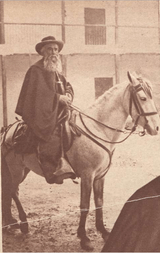
Following the ultimate Conservative victory in 1902 Santa Cruz founded the village of San Ignacio,[73] located in the Andes some 20 km north of Pasto in the county of Buesaco;[74] for the second time since the Hernialde spell he assumed the role of a parson. The hamlet was inhabited by an extremely poor indigenous population; it seems that apart from providing spiritual service, Santa Cruz tried to support it economically. Teaching the locals agriculture, he travelled across the county begging, with the money collected dedicated to needs of the San Ignacio natives.[75] Santa Cruz spent some 18 uneventful years in San Ignacio[76] and according to some sources was greatly respected among the locals for his apostolic work but also for his personal humility and exemplary life;[77] his most lasting achievement was construction of the local San Ignacio church.[78]
Santa Cruz retained his reactionary ultra-conservative outlook; during local electoral campaigns he used to instruct his flock how to dodge the corrupted election system and vote the candidates he considered right.[79] It seems that he also remained a Carlist; he corresponded with his old-time war comrades back in Spain[80] and in a separate letter pledged loyalty to Don Jaime,[81] though there are suggestions he also recognized Don Alfonso.[82] In 1920 he was eventually admitted to the Jesuit novitiate and in 1922 he formally entered the order.[83] It is not clear where Santa Cruz spent his senility; in the Pasto monastery or in San Ignacio, where he was eventually buried in the church he constructed.[84]
Black legend
_-_Fondo_Car-Kutxa_Fototeka.jpg)
Since January 1873 the press[85] reported misdeeds of Santa Cruz,[86] dubbed assassin, criminal or barbarian.[87] In 1874-1876 newspapers speculated about his re-entry into war.[88] In the late 1870s media lost track of him until he was located in Jamaica in the mid-1880s,[89] and his name reverberated as a memory of past atrocities. In 1880 he became one of the key protagonists of Vida, hechos y hazañas del famoso bandido y cabecilla Rosa Samaniego,[90] a short novel written by an unidentified author. The book portrayed Santa Cruz as a bloody ringleader; with many fictitious episodes[91] it became very popular and was re-published until the early 1890s.[92] In the press Santa Cruz was not infrequently mentioned also as a sample of treacherous clergy.[93] From time to time he was reported back in Europe;[94] as speculations about another Carlist insurgency were on the rise in the late 1890s Santa Cruz was even reported seen in Spain.[95] The wildest rumor had it that his son was to command a new Carlist unit.[96] A monument was erected in Enderlaza to honor the executed carabineros.[97]
In 1897 Santa Cruz appeared in Paz en la guerra by Miguel de Unamuno and for some 20 years he kept featuring in greatest works of Spanish literary Modernism. In 1906 he was treated somewhat more extensively in Sonata de invierno by Ramón Valle-Inclán,[98] in 1908 in Zalacaín el aventurero by Pio Baroja, and in 1909 in two subsequent novels of Valle-Inclán, El resplandor de la hoguera and Gerifaltes de antaño;[99] in the latter he was one of the two key protagonists. Finally, in 1918 Baroja dedicated to him a set of essays El cura Santa Cruz y su partida.[100]

The role assigned to Santa Cruz by all 3 giants of Spanish literature differed. Baroja from his Nietzschean perspective portrayed Santa Cruz as a little man who disguised his inferiority with cruelty and epitomized "double barbarity of being a Catholic and a Carlist".[101] In the case of Unamuno it is believed that Santa Cruz stood for an inflexible model of orthodoxy, be it religious, political or otherwise, a model which was valid only within a set of parameters; Unamuno rejected it and presented the Spanish self as a result of dialectic interaction.[102] Even more complex is the vision of Valle-Inclán. Some claim that Valle-Inclán presented dominant and at times even monstrous personalities of the past to confront them with meager men populating contemporary Spain.[103] Others maintain that Valle-Inclán intended to evoke the atmosphere of ominous drama with satanic personalities.[104] Whatever their intentions were, the noventayochistas and especially Baroja transformed a somewhat crude newspaper version of Santa Cruz into a powerful literary image enriched with diabolic and demonic features. This image persisted well into the 1930s,[105] at times enhanced with new threads, e.g. this of "cura fascista".[106] In the Francoist Spain the anti-Liberal stand of El Cura rendered cultivation of the black legend hardly feasible.[107] After transición it was already a forgotten past which hardly elicited emotions;[108] if so, they were much more ambiguous.
White legend

Carlism initially ignored Santa Cruz.[109] Re-calibrating the movement as "party of order", until late Restoration, Traditionalist politicians viewed him as an inconvenient ghost from their past.[110] Things changed upon his death.[111] The late 1920s saw three apologetic works,[112] two flavored with Carlism; Bernoville[113] focused on Catholic regionalism while Olazábal[114] on Integrism;[115] the third one by Orixe advanced Basque threads.[116] Confrontational political milieu of the Republic helped the Carlists to re-claim Santa Cruz,[117] e.g. in poetry,[118] and upon outbreak of the civil war Traditionalist press linked military virtues of Requetés to these of El Cura.[119] The Enderlaza monument was blown up by Carlist troops advancing from Navarre to Gipuzkoa in July 1936,[120] but got silently reinstated in 1940.[121] Two major Carlist historiographical works, written by Oyarzun in the 1940s[122] and by Ferrer in the 1950s, approached El Cura with caution.[123] In popular propaganda there were cases of exaltation[124] yet Santa Cruz did not become an orthodox mythical hero.[125] Youths from the progressist faction of Comunión Tradicionalista tried to re-claim El Cura, and in the early 1970s their terrorist organisation GAC declared that "the flag of Santa Cruz has been raised again".[126] Today Santa Cruz marginally features on some private Carlist websites.[127]
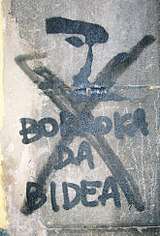
In the vasco-navarrese area the Carlist social base was gradually taken over by Basque nationalism.[128] Its radical faction attempted to re-format the image of Santa Cruz accordingly;[129] violence and fanaticism were converted into virtues.[130] El Cura started to feature in nationalist propaganda as a convenient hyperbole for violent action; in the 1980s the Herri Batasuna newspaper Egin ran a series of lengthy articles on El Cura and no nationalist figure dared to criticize him.[131] As a result, papers noticed "admiration of left-wing youth for legendary Santa Cruz"[132] and Baroja observed that "you can meet Cura Santa Cruz on any Basque street today."[133] The vision of El Cura as spiritual embodiment of "these mountains", unforgiving but idealistic, was pursued in a 1990 Basque film of José Tuduri.[134] Also a Basque historiographical study by Xabier Azurmendi[135] set the protagonist deeply against the Basque background. Today Santa Cruz is still present in nationalist discourse and features on some websites, usually flavored with radical Left-wing politics.[136] In 2008 a Basque band Bizardunak released a song[137] which cultivates the Santa Cruz myth; it remains in public circulation with references to ETA.[138]
A new kind of narrative started to emerge in Colombia in the 21st century. Fundación Manuel Santa Cruz Loydi was set up to honor his work for the poor and to preserve his memory as exemplary missionary, who possibly bordered sanctity.[139] The organisation strives to renovate the decayed San Ignacio church.[140] Its leader, a historian Isidoro Medina Patiño, in 2005 released two versions of another biography, this time focused on his American period;[141] he declares that the Santa-Cruz-related "conceptos canonizados de bueno o malo, pueden confundirse o alterarse", yet both versions remain highly apologetic and present a man who spent his life serving the others;[142] for a similar role in Jamaica he is also acknowledged in Catholic encyclopedia.[143]
Notes
- Juan de Olazabal y Ramery, El Cura Santa Cruz Guerrillero, San Sebastián 1979, p. 71, referred after Iñigo Pérez de Rada Cavanilles, La Partida del Cura Santa Cruz y su Bandera, [in:] Noticias Carlistas service, 16.06.2011, available here
- Gaëtan Bernoville, La cruz sangrienta. Historia del cura Santa Cruz, Tafalla 2000, ISBN 848136181X, p. 18
- unknown by name, a sister of Manuel Santa Cruz was reportedly a protagonist of one of his wartime episodes, exchanged for a Liberal official
- Pérez de Rada Cavanilles 2011
- according to some sources Francisco Antonio Sasiain Santa Cruz was the uncle of Manuel Santa Cruz, Bernoville 2000, p. 18
- Bernoville 2000, p. 20
- Pérez de Rada Cavanilles 2011
- Bernoville 2000, p. 20
- Pérez de Rada Cavanilles 2011
- compare e.g. the Basque folk rhymes, gathered in Antoni Zavala (ed.), Karlisten Bigarren Gerrateko bertsoak, Oiartzun 1997, ISBN 8489080585
- Bernoville 2000, pp. 17–20
- Basque and Navarrese seminars and religious orders of the time are considered "foco de integrismo religioso", Iñaki Anasagasti, El cura Santa Cruz, [in:] Ianasagasti blog service, available here, see also Juan Cruz Labeaga Mendiola, Memorias de exilio de un clérigo carlista (1858-1869), [in:] Príncipe de Viana 59 (1998), p.829
- Bernoville 2000, p. 27
- details of the episode differ; some authors claim there were just two civiles, see e.g. Bernoville 2000, p. 27; other maintain there were some 20–30 officials deployed to detain Santa Cruz, Roman Oyarzun, La historia del carlismo, Madrid 1969, p. 331
- the escape served as the first in a long string of anecdotes which used to build the later Santa Cruz’ legend. When approached by the civiles by the end of the mass Santa Cruz asked whether he could have breakfast and suggested that they have some chocolate with him. As they declined Santa Cruz led them to the clergy house and left both at the ground floor, going upstair allegedly to change. He then jumped out of the first floor window, Bernoville 2000, pp. 27–28
- Juantxo Egaña, Las imágenes de Ladislas Konarzewski, [in:] juantxoegaña service 31.12.09, available here
- when the unit of his commander Recondo surrendered in May 1872 Santa Cruzed refused to follow suit and fled
- in August 1872 he was captured by governmental troops; he managed to escape from a building in Aramaio he was held at from the balcony and then spent many hours (numbers given vary up to "the whole day") under a bridge in the ice-cold river, for long periods all under water and breathing with a straw; he then made it to the French border. Except the Enderlaza carnage, the Aramaio episode is probably the best-known chapter of Santa Cruz' wartime history and the key one building his myth. For one of the accounts see Bernoville 2000, pp. 45–49
- the first half of 1873 was the climax of Santa Cruz' activity, with some 20 belligerent episodes noted between January and June; he decided to abandon arms under pressure from the Carlist high command
- following few idle months in the French Pyrenees Santa Cruz gave in to the pressure of his men and returned to arms, but December 1873 was pretty uneventful and following another showdown with Lizarraga ended with the last and ultimate withdrawal into France
- Narración militar de la guerra carlista de 1869 à 1876, Madrid 1883, p. 370
- according to a contemporary historian the unit of Santa Cruz "was among the most efficient ones" when it comes to sabotage actions, Jose Andres-Gallego (ed.), Historia general de España y América vol. XVI/2, Madrid 1981, ISBN 8432121142, p. 253
- by ambushes against postal stagecoaches or destroying postal stations
- e.g. on August 6, 1872 Santa Cruz and his unit ambushed an arms transport from Mondragón, seizing some 50 Berdan and Remington rifles, see Narración militar de la guerra carlista de 1869 à 1876, Madrid 1883, p. 202
- the unit of Santa Cruz was derailing trains and demolishing railway terminals, e.g. on January 18, 1873 the Santa Cruz unit attacked the railway station in Hernani and burnt it down
- e.g. in June 1872 he took control of Azcoitia or in February 1873 he raided Deva
- for detailed though apparently biased acoount, which portrays the Aia episode as a treason on part of Lizarraga, see Bernovilla 2000, pp. 69–79
- e.g. in August 1872 Santa Cruz operated in the region of Arrazola, Iñaki Anasagasti, Algunas peripecias del cura Santa Cruz, [in:] Ianasagasti blog service, available here
- in the Navarrese town of Vera de Bidasoa he set up one of his headquarters
- his unit sported a "guerra sin cuartel" ("no-mercy war") banner with skull and bones insignia
- tha case which caused particular outrage was abduction and later execution of a mayor of Anoeta, Anjel Rekalde, Dorregarai: la casa torre, Tafalla 1992, ISBN 9788486597511, p. 110
- allegedly Santa Cruz twice spared a woman he charged with spying; when detained for the third time, she was eventually executed, Bernoville 2000, p. 88
- in later literature he was charged with ordering humiliating sanctions, also against females, see e.g. references in Gerifaltes de antaño by Ramón Valle-Inclan or Zalacain el aventurero by Pio Baroja, who suggest that Santa Cruz used to subject women to tarring and feathering; however, the information is not confirmed in scientific historiography
- for the best account available see Mikelatz, Los Fusilamientos de Endarlaza: Crónica de un Desastre Anunciado, [in:] Hechos, Anécdotas y Relatos de Las Guerras Carlistas service 10.12.16, available here
- the Carlist general staff was getting perplexed by activity of Santa Cruz for a number of reasons. His independent military actions might have triggered moves of large Liberal troops which in turn might have caught regular Carlist units by surprise. The brutality of El Cura damaged reputation of the claimant, especially that he posed as representative of godly law and order. Still worse, Santa Cruz undermined the credibility of Carlist high command; they have concluded deals with local railway companies and Santa Cruz’s actions against the infrastructure, like derailing trains or burning terminals, was causing trouble
- Jordi Canal, El carlismo, Madrid 2000, ISBN 8420639478, p. 180
- Santa Cruz does not elicit much interest from present-day historians. For a brief and unbiased recent account of his wartime deeds and later reception by a professional historian see Canal 2000, pp. 179-182. The latest larger study on Santa Cruz, Vicente Garmendia, Memorias levemente apocrifas del cura Santa Cruz, San Sebastian 2007, ISBN 9788497972345, is basically focused on dismantling the myth of Santa Cruz
- Bernoville 2000, p. 145
- Santa Cruz was hosted either by former members of his unit or by his acquaintances, Bernoville 2000, pp. 145–146
- Bernoville 2000, pp. 146–147
- La Correspondencia de España 19.07.23, available here
- Bernoville 2000, p. 148
- Bernoville 2000, pp. 148–149
- when leading the guerilla unit Santa Cruz did not conduct regular religious service; there was another chaplain in his unit, who was taking care of sermons, confessions, funerals etc.
- according to later accounts of his guerilla subordinates already in 1874 Santa Cruz declared he was no longer a military commander but rather a missionary, and took some preparatory steps for would-be service in America, Bernoville 2000, pp. 146–147
- for an ambiguous account see Julio de Urquijo, La Cruz de Sangre. El Cura Santa Cruz, pequeña rectificación histórica, San Sebastián 1928, pp. 61–62, referred after Pérez de Rada Cavanilles 2011
- Bernoville 2000, p. 150
- during the London meeting Carlos VII, who during the war authorised orders against Santa Cruz and called him a traitor, pardoned Santa Cruz, Francisco Melgar, Veinte años con Don Carlos. Memorias de su secretario, Madrid 1940, p. 83, similar account in Manuel Polo y Peyrolon, D. Carlos de Borbón y de Austria-Easte, Valencia 1909, p. 56
- one source claims also that his trip was made possible by donation of "a pious English lady", Bernoville 2000, p. 150
- in 1866 there were 4,110 Catholics in Jamaica, two thirds of them in Kingston, Kathryn Wirtenberger, The Jesuits in Jamaica [MA thesis Loyola University], Chicago 1942, p. 66
- Francis J. Osborne, History of the Catholic Church in Jamaica, Austin 1977, ISBN 9780829405446, p. 264
- Roman Catholic Baptisms 1876, [in:] Jamaican Family Search Genealogy service, available here
- Handbook of Jamaica 1891-1892, The Church of England and Roman Catholics, [in:] Jamaican Family Search Genealogy service, available here; a religious identified as "E. Loidi" is almost certainly Santa Cruz, as at that time there were no more than 10 Catholic religious on the island
- The Church of England and Roman Catholics, [in:] Jamaican Family Search Genealogy service, available here
- see Baptisms section, Roman Catholic Baptisms (A-J). King’s Weston, [in:] Jamaican Family Search Genealogy service, available here
- see Marriages section, Roman Catholic Baptisms (K-Y). King’s Weston, [in:] Jamaican Family Search Genealogy service, available here
- Roman Catholic Burials, [in:] Jamaican Family Search Genealogy service, available here
- Bernoville 2000, p. 150
- Wirtenberger 1942, p. 63
- Michael Burke, 500 Years of Christianity in Jamaica, [in:] Jamaica Observer 26.04.12, available here
- in 1887 one Jesuit missionary noted: "We are all as poor as can be. Once in the country, a piece of honeycomb was sent in for my breakfast, with a request that I would return the wax. Very few of them own beds; they sleep on a mat on the ground”, Wirtenberger 1942, p. 91; others mention that Santa Cruz lived in "austeridad", "rigidez" and lack of "cualquier clase de comodidad", Bernoville 2000, p. 150
- Wirtenberger 1942, p. 92
- Bernoville 2000, p. 151
- though the Jesuit college in Pasto existed since 1772, it opened a secondary school module in 1885, see Historia, [in:] Colegio Javierano web service, available here
- Francisco Celis Alban, De terrorista a santo, [in:] El Tiempo 14.12.2003, available here
- Celis Alban 2003
- Bernoville 2000, p. 152
- Isidoro Medina Patiño, Don Manuel: el temible cura guerrillero, Bogota 2005, ISBN 9789583372285, referred after Celis Alban 2003
- Bernoville 2000, p. 151
- Bernoville 2000, p. 152
- Celis Alban 2003
- Celis Alban 2003
- La Compañia de Jesús en Pasto, 1599-1985, Pasto 1985, p. 155
- Iñaki Anasagasti, El aporte vasco contemporáneo en Colombia, [in:] Ianasagasti blog service, available here
- Celis Alban 2003
- it is not clear whether Santa Cruz resided permanently in San Ignacio or whether he used to come to the village on Fridays, his arrival announced by a small trumpet he kept since his Gipuzkoan wartime years, Páginas escolares 264 (1927), p. 4, available here
- Una fundación colombiana reivindica la vida de entrega del Cura Santa Cruz, guerrillero vasco del XIX que vivió durante más de tres décadas en Colombia, [in:] Euskalkultura service 30.12.2003, available here
- Campaña para recuperar capilla de Cura Santa Cruz Loydi, [in:] YouTube service, available here
- Gustavo Jiménez Cadena, Es buen negocio vender su voto? [in:] Ecos de Pasto 740 KHz service, available here
- Bernoville 2000, p. 153
- Juan María Roma (ed.), Album histórico del carlismo, Barcelona 1933, p. 241
- Páginas escolares 264 (1927), p. 4, available here
- Bernoville 2000, p. 154
- slightly other dates are provided in Martin Ugalde Orradre, Nueva Síntesis de la historia del pueblo vasco, Donostia 2010, ISBN 9788498432312; the author claims that Santa Cruz worked on mission in Colombia from 1891 (not 1892) till 1922, when he retired to monastery life
- mostly Spanish, though also the foreign one; in Britain Harper's Weekly agonized about "a priest who has won a terrible renown by his unsparing cruelty", Harper's Weekly 03.05.73, available here. However, some English titles without renouncing their utmost hostility sort of advanced kind of romantic gloom of a rebel, e.g. naming Santa Cruz "Jack Sheppard of Gipuzkoa", The Atenaeum 11.04.74, available here
- for a list of crimes he was charged with see El Motin 25.11.09, available here
- "barbarian" – La Iberia 06.03.73, available here, "assassin" – El Imparcial 13.01.73, available here, "bloody priest" – El Imparcial 05.03.73, available here, responsible for crimes – La Iberia 22.01.73, available here, and ferocities – Revista de España 1873, available here; in early 1873 he was already "tristemente celebre", El Periodico para Todos 13 (1873), available here
- some titles claimed he had been noticed in specific locations in Spain and was to assume command, La Epoca 03.12.1874, available here
- El Motín 25.11.86, available here
- Amelina Correa Ramón, Otra novela histórica del carlismo: La sima de Igúzquiza (1888), [in:] Angeles Ezama et al. (ed.), Aún aprendo. Estudios dedicados al profesor Leonardo Romero Tobar, Zaragoza 2012, ISBN 9788415538233. p. 286
- e.g. the novel linked Santa Cruz to Rosa Samaniego, while in fact, the two commanders have never met
- the last identified re-edition is form 1893, compare GoogleBooks service, available here
- another chaplain who gained sort of notoriety as commander of a Carlist military unit - though definitely not comparable to this of Santa Cruz - was Pedro Valentín Argüeso Gonzalez, the so-called "Cura de Lanchares", active in Cantabria. Like Santa Cruz, he also migrated to America, for details see Mikelatz, El “Cura de Lanchares”: Retazos de la Cantabria Carlista, [in:] Hechos, Anécdotas y Relatos de Las Guerras Carlistas blog 18.01.2020, available here. Another religious man usually listed together with Santa Cruz as a sample of disloyal priest was the bishop of Urgel, see e.g. Las Dominicales 15.08.84, available here
- La Correspondencia de España 20.12.88, available here
- e.g. in 1897 Santa Cruz was reported seen in Bilbao, El Día 13.02.97, available here, and in Oyarzun, see La Epoca 21.02.97, available here. The Carlist hierarchs felt compelled to dismiss the news, see El Movimiento Católico 19.02.97, available here
- La Correspondencia Militar 14.09.99, available here; it was soon corrected that the man in question was Santa Cruz’ nephew, Heraldo de Madrid 14.09.99, availavle here. Even the foreign press speculated that "exploits of the famous and bloodthirsty priest Santa Cruz would doubtless be imitated by many gentlemen of his sacred calling", James Roche, The Outlook for Carlism, [in:] The North American Review 168/511 (1899), p. 742
- a modest monument was first erected in 1907, replaced with a larger construction in 1913, Mikelatz 2016
- the key protagonist was another Carlist, Marqués de Bradomin; Santa Cruz was mentioned in passing
- interesting comments in Ernest Augustus Boyd, Studies from Ten Literatures, New York 1925, p. 94
- Baroja wrote El cura Santa Cruz y su partida upon the false news that Santa Cruz had died in Colombia, Juan Van Halen, Baroja y la historia, [in:] Pio Baroja, Juan van Halen, Madrid 1998, ISBN 9788441404069, p. 15
- Juan Carlos Ara Torralba, Pérez Galdós y Baroja frente al carlismo, [in:] Imagenes en carlismo en las artes, Estella 2009, ISBN 9788423532278, p. 37
- "El rol del cura Santa Cruz al apoyar tanto al lado carlista como el lado católico y en interesarse sólo en su propia grey creyente destaca el papel inherente de una religión oficial como determinante sociológico de las creencias y del grupo en boga ... El cura, en este caso, siente que él tiene el derecho de fijar la ortodoxia cristiana además de añadir exigencias violentas para los fieles, reduciendo —según él— la salvación solamente a los seguidores de su autoridad. Su deseo de sólo atender a quienes aceptan sus mandatos limita aún más el concepto de la salvación universal de Cristo. Posiblemente, el rechazo del adolescente Unamuno a esa bomba fratricida, disfrazada de cristiana, haya sido semilla de su futuro desencanto con una religión vista como manipulación al servicio del poder o de prestigios personales y partidistas", Kevin Fagan, La libertad de conciencia en Miguel de Unamuno, [in:] Alpha 29 (2009), p. 293. Some authors claim that Santa Cruz inspired Unamuno to write his late "nivola", San Manuel Bueno, Martír, a piece which allegedly presents the title protagonist as almost a saint, Celis Alban 2003. In fact, the title protagonist is an exemplary priest serving his community to the utmost; eventually, it is revealed that he did not believe in God
- Biruté Ciplijauskaité, Configuraciones literarias del Carlismo, [in:] Stanley G. Payne (ed.), Identidad y nacionalismo en la España contemporánea, el Carlismo, 1833-1975, Madison/Madrid 1996, ISBN 8487863469, p. 62
- Leda Schiavo, Historia y novela en Valle-Inclán, Madrid 1980, p. 29, referred after Ciplijauskaité 1996, p. 62
- see e.g. references to Santa Cruz as jackal or hyena, Diario de Almeria 23.01.34, available here
- El Liberal 17.06.36, available here
- Santa Cruz rather seldom featured in the press of 1940-1975, compare prensahistorica service, available here
- for contemporary cartoon version of the black legend see a sample here
- though liberal press referred to Santa Cruz whenever a threat of new Carlist unrest seemed looming, the movement did not accommodate Santa Cruz as a role model. He was missing in books listing heroes, claimants and commanders of the past, in leaflets and icononography featuring current political leaders, or in periodicals, see e.g. Francisco de Paula, Album de Personajes Carlistas con sus Biografias, vols. I-III, Barcelona 1888, or B. de Artagan [Reynaldo Brea], Políticos del carlismo, Barcelona 1912,
- in 1890 the party leader Márques de Cerralbo declared "no somos ni el cura Santa Cruz, ni Rosa Samaniego. Somos capaces de moralizar la administracion pública con nuestras doctrinas y procedimientos", Agustín Fernández Escudero, El marqués de Cerralbo (1845-1922): biografía politica [PhD thesis], Madrid 2012, p. 233
- the death of Santa Cruz was acknowledged in the Spanish press with information on his humble missionary activity prevailing. Already in the early 1920s he enjoyed somewhat more favorable treatment, e.g. some newspapers referred a letter he allegedly sent to the parish priest of his native village, - La Noche 24.11.24, available here, or in 1926 floated rumors about his penitent pilgrimage to Santiago de Compostela, Las Provincias 14.08.26, available here. A contemporary historian claims that "la muerte y el supuesto periplo de su alma [in 1920s he was referred in relation to a widely publicised mystic vision of a visionary Benita Aguirre] coincidiran, en todo caso, con una variacion muy significativa en el curso y en el tono de la literatura sobre su [Santa Cruz'] personaje", Canal 2000, p. 181
- which led some papers to conclude that "rigurosa revisión histórica" was ongoing, La Correspondencia de Valencia 17.09.32, available here
- Gaetan Bernoville, La Croix de Sang. Histoire du Curé Santa Cruz, Paris 1928; it was translated the same year into Spanish and published as La Cruz Sangrienta. Historia del Cura Santa Cruz, San Sebastián 1928 (308 pages)
- Juan Olazábal y Ramery, El Cura Santa Cruz guerillero, Vitoria 1928 (680 pages)
- the uncritical account of Santa Cruz, especially the one by Bernoville, was repelled by a Carlist Julio Urquijo in La Cruz de Sangre. El Cura Santa Cruz. Pequeña rectificación histórica, San Sebastián 1928 (62 pages)
- it was written in Basque and its declared purpose was pedagogical, to teach the Basques their past: "Santa Cruz’en berri ematen dun liburua ikusi ezkero, erriak gogotik elduko diola nago, ta eskeraz irakurtzea zaila bada era ... oituko al dire euskaldunak irakurtzen", referred after Gorka Aulestia, The Basque Poetic Tradition, Reno 2000, ISBN 9780874172836, p. 73
- Canal 2000, p. 182
- a Carlist poet Ignacio Romero Raizabal dedicated a poem to Santa Cruz, El Siglo Futuro 07.06.34, available here. Santa Cruz occasionally featured in poetry also earlier on, referred to evoke the atmosphere of heroism and savagery, see O Cura Santa Cruz by a Brasilian-Portuguese poet Gonçalves Crespo, Pedro Nava, Chão de ferro, vol. 3, Sao Paulo 2001, ISBN 9788574800226, p. 131
- Pensamiento Alavés 26.03.38, available herea
- Mikelatz 2016
- this time with no reference to perpetrators. It is not clear who ordered the monument to be re-erected, some authors suspect it was the work of some local military commander, Mikelatz 2016
- Roman Oyarzun, Historia del carlismo, Madrid 1969 [subsequent edition], pp. 330-335. Santa Cruz was presented as a rebelious and non-disciplined follower who caused more harm than good to the cause; he is deemed ultimately responsible for atrocities committed by his unit, though direct blame is laid on his lieutenants Frasku and Corneta, genuinely evil personalities
- Melchor Ferrer, Historia del tradicionalismo español, vols. XXIV-XXV, Sevilla 1958
- at times Cura Santa Cruz featured on equal footing with iconic Carlist personalities of the highest rank, like Carlos VII, Zumalacárregui or doña Margarita, see José Angel de Igarzabal, Acto cultural en Azcoitia, [in:] Montejurra 12 (1965), p. 22
- the most popular and best-selling Carlist review Montejurra, published in the 1960s, ran a section on history of Carlism. Not a single time Santa Cruz was featured as its protagonist
- Jeremy MacClancy, The Decline of Carlism, Reno 2000, ISBN 9780874173444, p. 165
- see e.g. Dos reliquias históricas del célebre guerrillero carlista Cura Santa Cruz han llegado a España, [in:] TradicionViva service 13.04.15, available here. Perhaps the site which most closely follows the Carlist Santa Cruz legend is ElBandidoRealista service, which in its iconographic layer is heavily based on mass-culture-adopted visual references to Santa Cruz, see e.g. Contra todos, [in:] ElBandidoRealista service 28.04.09, available here. Sixto Enrique de Borbon, who styles himself as a Carlist "standard-bearer", visited the village of San Ignacio in 2005, Un príncipe que vino a comer cuy en Pasto, [in:] El Tiempo 20.02.05, available here
- Santa Cruz was Basque and he spoke the Gipuzkoan Basque dialect as his mother tongue; also members of his unit were almost all Basques. Basque was the language of command and all communication; if any soldier spoke Spanish he had to excuse himself, José Ignacio Finez García, Fuerismo tradicionalista y nacionalismo vasco [PhD thesis Universidad Salamanca], Salamanca 2013, p. 44
- non-violent factions of Basque nationalism also claimed the memory of Santa Cruz, see e.g. the entry dedicated to El Cura and his reception in Eugenio Ibarzábal Aranberri, Días de ilusión y vértigo. 1977-1987, Bilbao 2016, ISBN 9788491091516
- Santa Cruz was presented as sort of gudari avant la lettre, Gaizka Fernández Soldevilla, Ecos de la Guerra Civil. La glorificación del gudari en la génesis de la violencia de ETA (1936-1968), [in:] Bulletin d’Histoire Contemporaine d’Espagne 49 (2014), p. 253
- MacClancy 2000, p. 236
- "admiración que sienten muchos jóvenes de izquierda por el legendario cura Santa Cruz", Caro Baroja denuncia los peligros del sincretismo cultural vasco, [in:] El País 17.03.81, available here
- Paddy Woodworth, The Basque Country: A Cultural History, London 2012, ISBN 9781908493224, available here. In the mid-1990s the press noticed a phenomenon of "santacrucismo urbano" among the Basque youth, José Antonio Ayestaran Leguona, Santacrucismo urbano, [in:] El País 13.07.95, available here
- Santa Cruz, el cura guerrillero (1 h 33 min), see filmweb; in the film Santa Cruz was dissociated from Carlism and presented as independent war leader guided by religious principles; the Carlists were presented as wealthy aristocratic señoritos. The film closes with commentary about the mountains which have always resisted the foreigners, see Santa Cruz, el cura guerrillero, [in:] YouTube service, available here. The film was not received well by the pundits and was a commercial success neither, Santa Cruz el Cura Guerrillero entry, [in:] Aunamendi Eusko Entziklopedia service, available here
- Xabier Azurmendi, El cura Santa Cruz, Bilbao 1986; some sources claim that Azurmendi merely edited the work, written by Ignacio Ariztimuño, see Euskonews service, available here
- see e.g. Borrokagaraia, El cupo. Antes integrista religioso que vendido autonomista, [in:] Borokagaraia service 04.05.17, available here, Aitonseme, Grandes Guerilleros II: el fundamentalismo anárquico del Cura Santa Cruz, [in:] Soul Guerilla service 03.11.15, available here, Santa Cruz apaiza Oñati inguruetan, [in:] Ahotsak service 22.01.09, available here
- titled Santa Kruz Apaizaren Kondaira, The Legend of Cura Santa Cruz
- compare visual references to ETA militants in Bizardunak - santa cruz apaizaren kondaira, [in:] YouTube service, available here; compare also international outcome here
- Una fundación colombiana reivindica la vida de entrega del Cura Santa Cruz, guerrillero vasco del XIX que vivió durante más de tres décadas en Colombia, [in:] Euskalkutlura service 30.12.03, available here
- Campaña para recuperar capilla del Cura Santa Cruz Loydi, [in:] YouTube service, available here, any many similar footage pieces
- Isidoro Medina Patiño, Don Manuel: el temible cura guerrillero, Bogota 2005, ISBN 9789583372285, and Isidoro Medina Patiño, Santa Cruz, el cura de la paz (e-book), Bogota 2005
- Publican en Colombia la segunda edición de una biografía del cura y guerrillero vasco Manuel Santa Cruz Loidi, [in:] Euskalkultura service 16.01.07, available here
- in a scholarly history of the Jamaica Jesuits Santa Cruz is not mentioned a single time, see Wirtenberger 1942, but is acknowledged in online New Catholic Encyclopedia, compare Jamaica, the Catholic Church in entry, [in:] New Catholic Encyclopedia online service, available here
Further reading
- Xabier Azurmendi, El Cura Santa Cruz, Bilbao 1990, ISBN 9788475470412
- Pio Baroja, El Cura Santa Cruz y su partida, Madrid 1918
- La Compañia de Jesús en Pasto, 1599-1985, Pasto 1985
- Gaëtan Bernoville, La cruz sangrienta. Historia del cura Santa Cruz, Tafalla 2000, ISBN 848136181X
- Vicente Garmendia, Memorias levemente apocrifas del cura Santa Cruz, San Sebastian 2007, ISBN 9788497972345
- Isidoro Medina Patiño, Don Manuel: el temible cura guerrillero, Bogota 2005, ISBN 9789583372285
- Juan Olazábal y Ramery, El Cura Santa Cruz guerillero, Vitoria 1928
- Julio Urquijo, La Cruz de Sangre. El Cura Santa Cruz. Pequeña rectificación histórica, San Sebastián 1928
External links
- website of Colegio Javieriano in Pasto, Colombia
- campaign to restore San Ignacio church in Colombia on YouTube service
- Santa Cruz in Auñamendi Eusko Entziklopedia online
- 1990 movie Santa Cruz El Cura Guerrillero online
- Santa cruz apaizaren kondaira 2008 song by Bizardunak
- Por Dios y por España, contemporary Carlist propaganda (Santa Cruz missing)
- Gora Jainko maite maitea Basque Carlist anthem
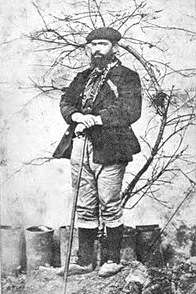
_-_Fondo_Mar%C3%ADn-Kutxa_Fototeka.jpg)
